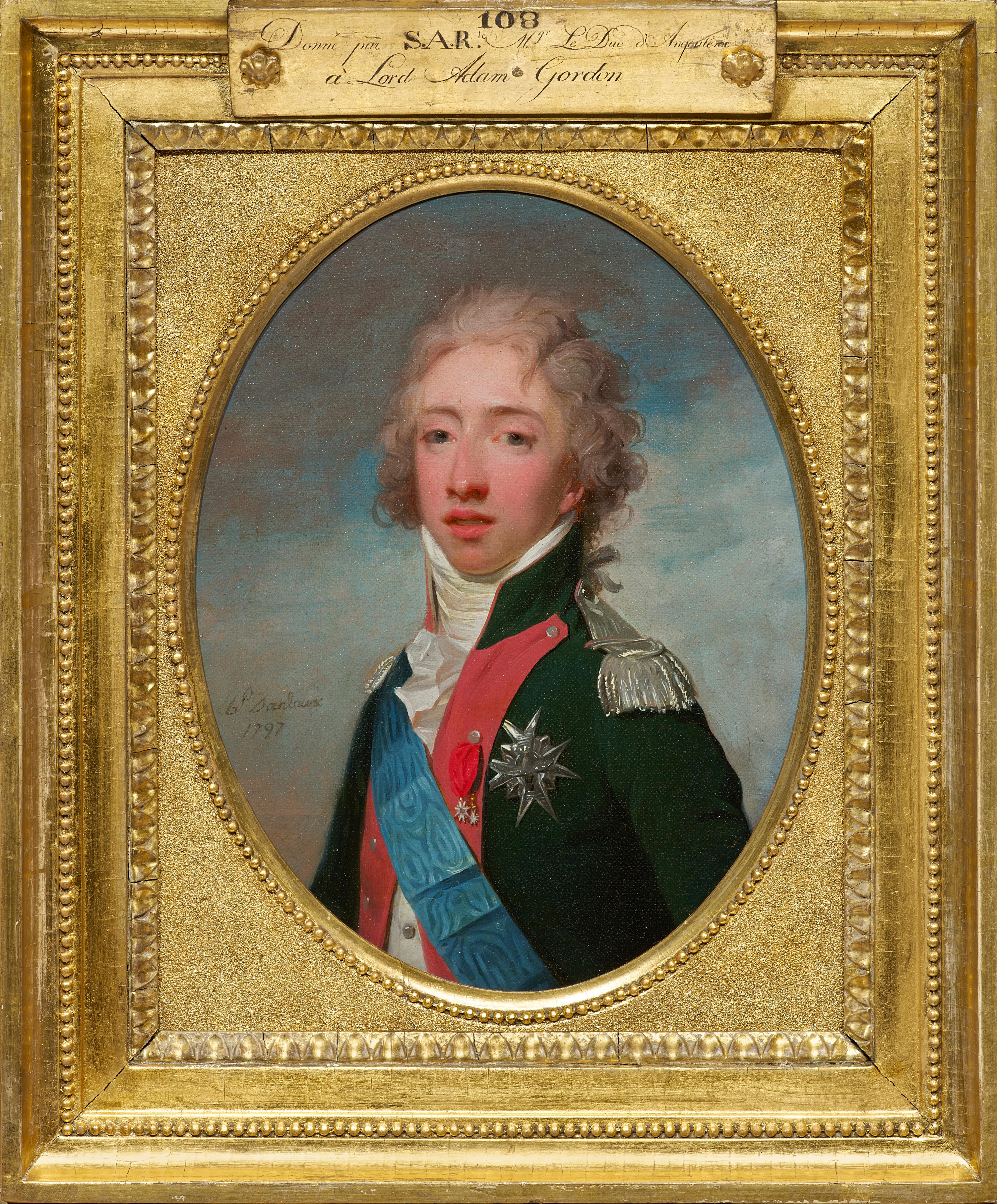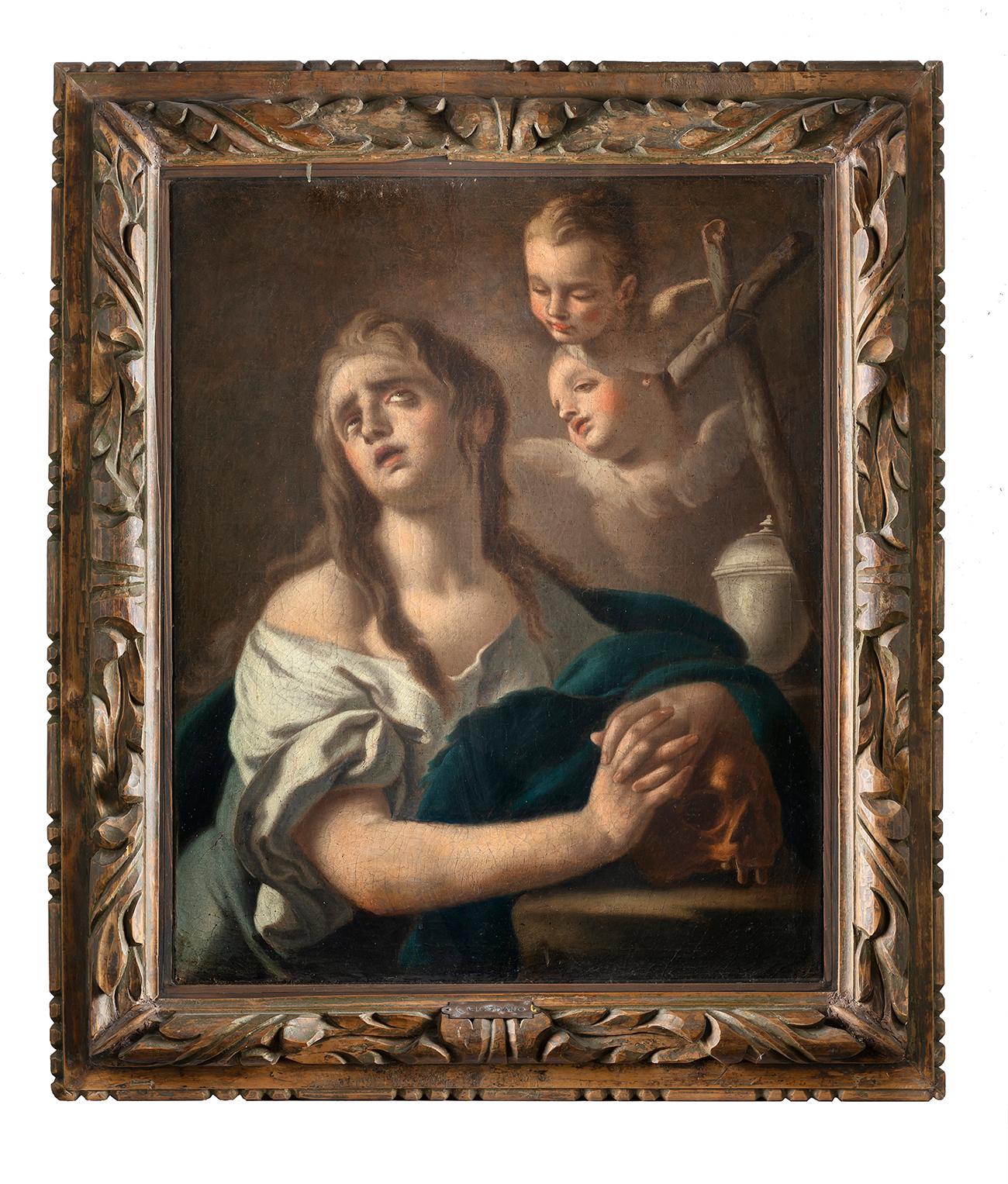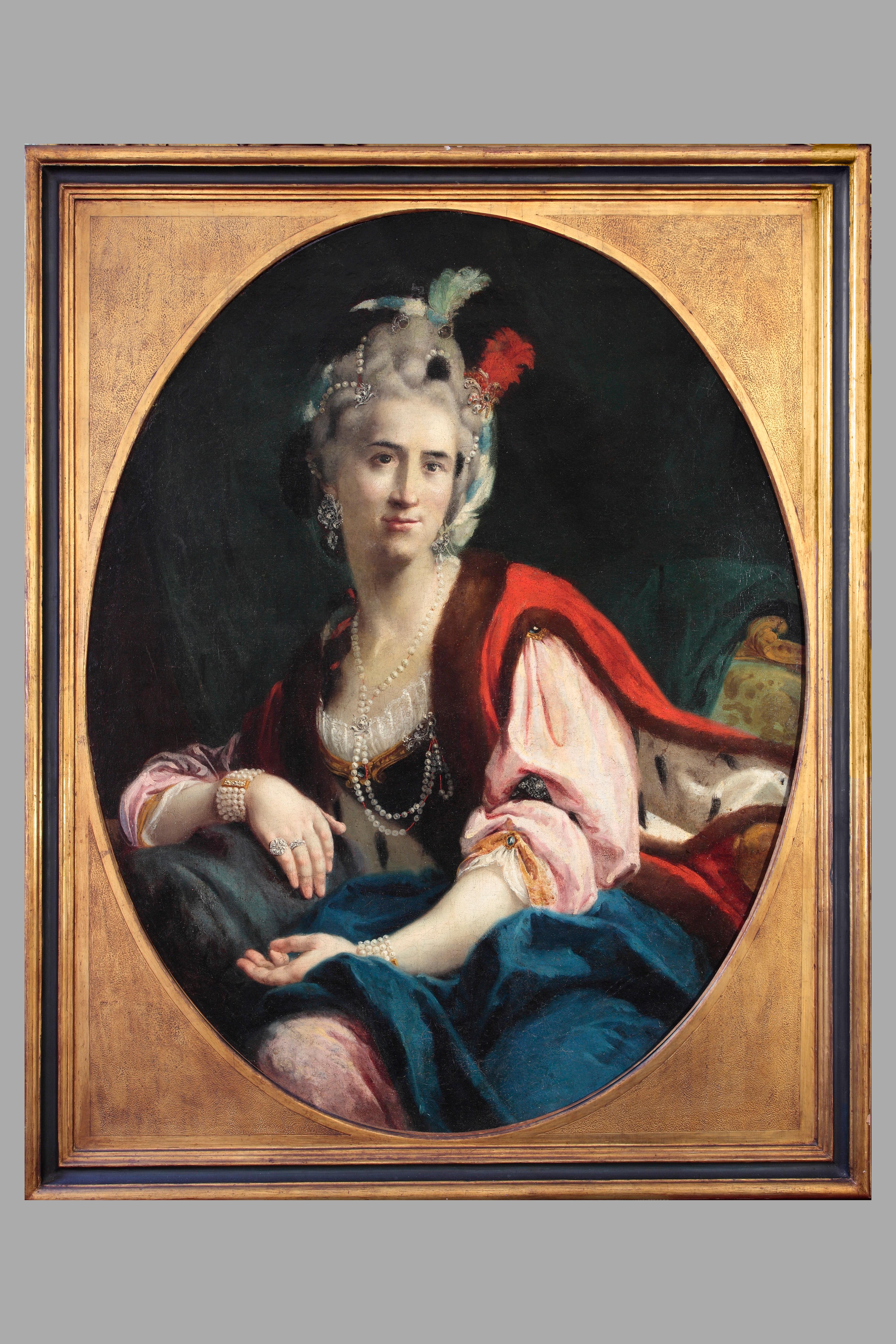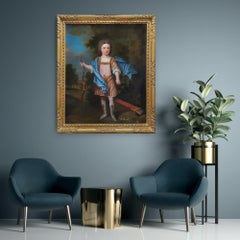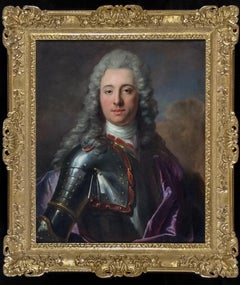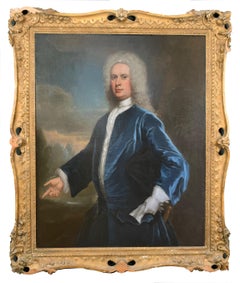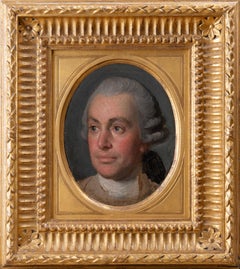
PORTRAIT of the Duchess of Brunswick-Wolfenbüttel (1715-1797), Fine Frame
View Similar Items
Want more images or videos?
Request additional images or videos from the seller
1 of 9
PORTRAIT of the Duchess of Brunswick-Wolfenbüttel (1715-1797), Fine FrameCirca 1730
Circa 1730
About the Item
- Creation Year:Circa 1730
- Dimensions:Height: 20.08 in (51 cm)Width: 16.54 in (42 cm)Depth: 1.19 in (3 cm)
- Medium:
- Movement & Style:
- Period:
- Condition:
- Gallery Location:London, GB
- Reference Number:1stDibs: LU119914453822
About the Seller
5.0
Vetted Seller
These experienced sellers undergo a comprehensive evaluation by our team of in-house experts.
Established in 1998
1stDibs seller since 2019
30 sales on 1stDibs
Typical response time: 1 hour
More From This SellerView All
- Portrait of a Young Gentleman, Pieter Van Der Dvssen; by Jan van HaensbergenBy Jan Van HaensbergenLocated in London, GBPortrait of a Young Gentleman, Pieter Van Der Dvssen c.1664 Jan van Haensbergen (1642–1705) This charming portrait is an excellent example of late 17th century child portraiture and is from one of the most prolific periods in art history – the Dutch Golden Age. A vast number of artists produced work to fulfil the demands and tastes of a broad Dutch society, and many cities in the Netherlands developed into distinct artistic centres, characterised by style and specialities of subject. The quality of our portrait is similar to the works of the highly specialised ‘fijnschilders’, who were working in Leiden at the time; these artists executed meticulous small-scale paintings. As with the artist’s other works of children, Haensbergen painstakingly recorded many details including a fine depiction of the face, and the surface effects of the materials and the pearl clasps. The young sitter is Walther Bernt Pieter Van der Dussen. He was born into a wealthy noble Catholic family in Delft in 1654. In this portrait he would be around ten years of age, dating the work to circa 1664, which is also the year before the artist’s marriage to Johanna van Heusden. The Van der Dussen family were great patrons of the arts and commissioned a number of major works from eminent artists in Delft & Amsterdam. Van der Dussen died in 1716. The wooded setting, the lamb, and the “picturesque” or “Roman” dress...Category
17th Century Old Masters Portrait Paintings
MaterialsCanvas, Oil
- Portrait of Young Gentleman, Lord George Douglas, Arcadian Landscape c.1710Located in London, GBPortrait of Young Gentleman, Lord George Douglas, in an Arcadian Landscape c.1710 Attributed to Charles D'Agar (1669-1723) Depicted with bow in hand and situated against an Arcadian...Category
18th Century Old Masters Portrait Paintings
MaterialsCanvas, Oil
- Portrait of a Gentleman in Armour and Mauve Cloak c.1740; Louis Tocque, PaintingLocated in London, GBThe sitter in this superb portrait, presented by Titan Fine Art, is shown with the grandiloquence characteristic of the eighteenth-century French school of painting. The young nobleman has been portrayed wearing an ingeniously embellished French ceremonial armour, a mauve cloak, and an abundance of cascading curls falling below his shoulders. Our portrait proclaims to every onlooker that this is a superior being. The manner in which portraits were painted was set out by the terms of the commission and usually marked significant life events such as a betrothal, a death, elevation of rank… but they almost always emphasised the wealth and importance of the sitter. This type of portrait had become a standard format for aristocratic portraiture in Europe during the last quarter of the seventeenth century up to the middle of eighteenth century. Incorporated into the background was often a raging battlefield or a military encampment; our portrait is free from these trappings and contains a dramatic moody sky ensures the viewer focuses mainly on the subject. The features of the sitter’s face have been captured with great sensitivity, his confident gaze perhaps reflecting the near invincibility afforded by this steel suit. The flamboyance and penetrating sense of character, lending an air of noble expectancy to the composition, seems almost eclipsed by the artist's virtuosic handling of paint. It is not hard to understand why many wealthy sitters commissioned the artist to paint their portraits. Such fine and ornate armour was not actually used on a battlefield and thus its portrayal in portraiture was largely symbolic of a sitter’s wealth and status as well as a claim of succession to a chivalrous tradition. The style of hair and neckcloth were fashionable circa 1740. Held in an exquisite eighteenth century carved and gilded frame - a fine work of art in itself. Louis Tocqué was a very successful French portrait painter active during the Rococo period of art. His work was known for its attention to detail, its portrayal of the character of the sitter, the refined postures, and the delicacy of the rendered draperies. He created both realistic and expressive portraits. Tocqué was born in Paris in 1696 and trained with the famous portrait painters Hyacinthe Rigaud, Nicolas Bertin, and Jean Marc Nattier whose daughter he later married. He entered the Academy in 1731 and became a full member in 1734 with his portraits of Galloche and the sculptor Jean Louis Lemoine, and he pursued a brilliant career as a portrait painter, receiving numerous commissions from members of the French aristocracy and royalty. His works were highly sought after by collectors of the time, and his reputation earned him the appointment of official portrait painter to the court of France in 1746 – in fact he stayed at most of the courts in northern Europe. From 1737 to 1759 he exhibited a large number of works at the Salon. Tocqué's paintings can be found in museums and private collections around the world. Recent sales...Category
18th Century Old Masters Portrait Paintings
MaterialsCanvas, Oil
- Portrait of a Lady in an Elaborate Stone Cartouche, Oil on canvas PaintingBy Mary BealeLocated in London, GBPortrait of a Lady in an Elaborate Stone Cartouche c.1675-80 Mary Beale (1632-1699) Titan Fine Art present this superb portrait where the sitter has been portrayed wearing a low-cut white chemise under a gold silk robe with a draped light...Category
17th Century Old Masters Portrait Paintings
MaterialsCanvas, Oil
- English Portraits of Lady, Dorothy & Jane Wood c.1750, Remarkable Carved FramesBy John Theodore HeinsLocated in London, GBPortraits of a Lady, Dorothy and Jane Wood c.1750, Fine Carved Frames By John Theodore Heins (1697-1756) Titan Fine Art present these works, which formed part of a collection of family heirlooms of the Wood family who were from Bracon Ash, Norfolk, since the medieval period. Jane’s daughter Ann, was famously married on board the Foudroyant, off Naples, in a lavish ceremony in 1799, with Lord Nelson himself giving away the bride. The paintings descended within the family for around 275 years until recent and are exquisite examples of Georgian portraiture in England and are some of the best works by the artist. The original hand carved and gilded pierced frames are magnificent works of art in their own right. The sitters were two children, out of several, of Thomas Wood (1682-176) and Dorothy Huby (1700-1759). The family is from Norwich, which in 1720 was a city second in importance only to London. Their aunt, Jane Wood (1677-1756), was a Franciscan nun in Bruges. Dorothy Wood (in the blue dress) was baptised 2nd June 1726 and she died unmarried around 1759. Jane (in the pink dress) gave birth to at least six children during her thirty two-year marriage. She was baptised 14 Oct 1727 at Bracon Ash. Jane married Knipe Gobbet (1730/5-1791) who was Sheriff in 1768 (and Mayor in 1771) of the City of Norwich, and later Lieutenant-Colonel of the West Norfolk Regiment, in which corps he had served in for many years. According to Payne’s Universal Chronicle or Weekly Gazette the marriage took place on 7th July 1758. Knipe was born at his family seat, Tacolneston Hall, to parents George Gobbet, who was Sheriff in 1710, and Ann. The couple bought and lived in a house in Norwich (later known as Gurney’s Bank House) until 1778 before moving to another one at 10 St Stephen’s Street, Norwich. Later, they inherited the family seat of Tacolnestan Hall and lived there for the remainder of their lives. Knipe Gobbet was a prominent individual and in 1779 he gave the corporation of Norwich 100 pounds, to be disposed of as they might think proper, and soon after that he was presented with a handsome field tent, marquee, and camp equipage, in testimony of their esteem for his dedication to the defence and service of this country at a time when threatened by an invasion. Although Jane was baptised a Roman Catholic Knipe was a prominent local wine merchant, JP, Alderman, sheriff, mayor and Lieutenant. Roman Catholics may have paid lip service to religious conformity as they were excluded from certain areas of public life before the Catholic Emancipation Act of 1829. Such discrimination probably lies behind the why their children are included in the registers of both the Anglican church in Tacolneston and the Norwich Catholic church in the 1760s. Jane and Knipe had one son, Thomas, who died at the age of four of a small-pox inoculation in 1762 (memorial stones in the Church of All Saints, Tacolneston) and many daughters who were schooled at the Order of the Immaculate Conception of Our Lady, in Paris. Their oldest daughter, Anne (1760-1817) was born at Tacolneston Hall. She came to the convent 30 Sept 1774 and ten days later she went to Dames St Sacrament, Rue St Louis in Paris. Their second daughter, Dorothy (died suddenly of apoplexy 21st Nov 1813), came to the convent 19th July 1777 when she was 16 years old and returned to England 23 March 1779. Frances (baptised 22 Feb 1763) came to the convent 16th April 1772 when she was 9 years old and returned 29th May 1777 – however she returned again to the convent 16th May 1778 and left 15th Oct 1778 to return home again. She later married and her surname became Negri. Another daughter, Jane, is thought to have married Juan Manuel Martinez in 1784. There was also another daughter, Mary. The eldest daughter, Ann, first married Peter Bottalini of London 27 Oct 1783 at Tacolneston Hall. They had one son together. She then married on 9th July 1799, Dr William Compton (1733- Clifton 1824), the Chancellor of Ely and the next collateral male relation to the Earl of Northampton (he had earlier marriages to Caroline and Catherine). William Compton later retired from the Commons and spent many years on the continent acting as Chancellor of Ely by proxy from 1777 for the remainder of his life. The couple were British residents of Posilipo Naples and the marriage was hosted on board the Foudroyant, off Naples, where the bride was given away by the Right Hon. Lord Nelson himself. The marriage document, signed by Lord Nelson, Lady Emma Hamilton, Captain Thomas Hardy, and others descended within the family, until sold in a sale that raised worldwide interest in 2023, for £20,160. The document is accompanied by a contemporary manuscript account of the wedding, headed 'Paragraph for the papers, sent to Messrs Coutts & Co with request to have it inserted'. Lord Nelson was a household name in Britain due to his many victories, including the Battle of the Nile against the French Navy in August 1798 – which came before the Battle of Trafalgar in 1805. The document states: 'This is to certify that, on board the Foudroyant lying in Naples Bay, on the ninth of July 1799 the marriage between William Compton & Mrs Anne Bottalin, widow, was solemnized by me S. G. Comyn HM. Chaplain to the Right Honble Lord Nelson, H.M.S. Foudroyant, in the presence of'. With the following autograph signatures: Sir William Hamilton (1731-1803), Lady Emma Hamilton (1765-1815), Horatio Nelson, Viscount Nelson (1758-1805); Sir John Thomas Duckworth (1747-1817), Sir Thomas Masterman Hardy (1769-1839), John Rushout, 2nd Baron Northwick (1769-1859), Josiah Nisbet (1780-1830), John Tyson, William Compton and Anne Bottalin, and 2 others” The document sheds light on Nelson's lesser-known side of his character. William Compton ... received "a great many favours and kindnesses" from Nelson, and most especially "the kind interest" taken in sealing his union with a wife who made him "the happiest of mortals". Anne, the aforesaid spouse, said that the admiral's "good heart" had made her "as happy as I can possibly be on this earth" ... Midshipman Parsons remembered those days nostalgically, noting Emma's "graceful form" bending over her harp to bestow "heavenly music" upon the diners on the quarterdeck and the large-decked galley, flush with opera singers, that glided alongside to serenade the sunset of each day'. Tacolneston has an ancient history of which according to the Domesday Book, Edward I granted a weekly market to be held on a Wednesday at the manor of Tacolneston and two annual fairs. The church was rebuilt in 1503 and is dedicated to All Saints. The earliest view of Tacolneston is a print of 1781 when it belonged to Knipe Gobbet Esq. John Theodore Heins (1697-1756) was a painter whose work, at his best, shows detail of an exceptionally high quality. His portraits of Anna Maria Kett nee Phillips and her husband Henry Kett, painted in 1741, are exceptional and evidence that he had the ability to portray a likeness on par with some of the best portraitists in England at the time. Heins appears to have originated in Germany but moved to the UK and settled in Norwich around 1720. From 1720 to his death in 1756, Heins built up a fine reputation as a portrait painter and painted many members of prominent Norfolk families right up to his last year. He was commissioned in 1732 to paint a portrait of the Mayor of Norwich, Francis Arnam and also the previous year's Mayor Robert Marsh...Category
18th Century Old Masters Portrait Paintings
MaterialsCanvas, Oil
- Portrait of a Gentleman in Scarlet Robe Holding Flowers c.1675, Oil on canvasLocated in London, GBTitan Fine Art present this striking portrait, which was painted by one of the most talented artists working in England during the last half of the 17th century, John Greenhill. Gre...Category
17th Century Old Masters Portrait Paintings
MaterialsCanvas, Oil
You May Also Like
- Oil on Canvas Painting Portrait of the Italian Noble Family of Zanardi CountBy Lucia Casalini TorelliLocated in Firenze, ITThis museum quality old master oil on canvas formal portrait painting depicting the family of the Count Zanardi is signed by the artist- the female painter Lucia Casalini Torelli- and published in a book dedicated to Casalini Torelli’s workshop and academy. This palatial masterpiece artwork comes directly from the ancient Villa Maraini Guerrieri - Palidano di Gonzaga (Mantua), an historic Italian heritage building owned by the descendants of the family portrayed for more than two centuries, until 1998. The big scale of this oil on canvas masterpiece painting states the relevance of Lucia Casalini Torelli as a painter. The present artwork is a formal family portrait painting that aim to introduce the characters depicted according to their social role in the society. The noble family is all gathered under a loggia overlooking a park, the landscape in the background is partially covered by a beautiful red cloth on the right side. The father stands up and holds the hand of his eldest son, proudly introducing his future heir. The son wears a light-blue dress and red boots, he is depicted in a serious pose holding a black tricorn hat under his arm and a rapier sword on his belt. The mother wears an elegant gold and dark green brocade dress, she is sitting with her youngest daughter on her knees while her second son is by her side. The little daughter wears a lovely long red and dress with white lace and holds an apple on her hand. The son stands next to his mother and is dressed in a brown priestly clothes. This palatial old masters piece was probably painted in 1740 due to the similarities with Cardinal Doria’ s portrait, now on display at the Doria Palace Museum, the official residence of the Prince of Genoa. The painting features original canvas (“prima tela”) and antique original patina, it is in excellent overall condition considering the age, use and its large scale. A formal detailed condition report and the results of the inspection with the UV lamp accompanied by photos is available on request. As well as for its exceptional quality and quite perfect state of conservation, this painting is particularly important and even more valuable both for the artist who painted it and for its absolutely exclusive provenance. Lucia painted the most prominent and powerful noble families of her time, the location of these paintings is unknown to the art market as it is extremely likely that the portraits are still kept in private collections. Furthermore, Lucia was one of the most appreciated artists of her time, so important that she was admitted as a member of the academy at a time when women were forbidden to attend these studies. In 1706, Felice Torelli...Category
18th Century Old Masters Portrait Paintings
MaterialsCanvas, Oil
- Oil Painting Portrait, attributed to John Vanderbank (1694-1739)By John VanderbankLocated in Uppingham, GBOil Painting Portrait of John Campbell, 4th Duke of Argyll,, att to John Vanderbank (1694-1739) Housed in a swept frame which has been restored after photo. Canvas Size 50" x 40", Fr...Category
1690s Old Masters Portrait Paintings
MaterialsCanvas, Oil
- 18th century portrait of the painter Nathaniel DanceLocated in London, GBCollections: Robert Gallon (1845-1925); Private Collection, UK. Oil on canvas laid down on panel Framed dimensions: 11.5 x 10 inches This highly engaging, previously unpublished portrait by Johan...Category
18th Century Old Masters Portrait Paintings
MaterialsCanvas, Oil, Wood Panel
- 19th century portrait painted in St Petersburg in 1819Located in London, GBSigned, inscribed and dated, lower right: 'Geo Dawe RA St Petersburgh 1819', also signed with initials, lower centre: 'G D RA'; and signed and inscribed verso: 'Geo Dawe RA Pinxit 1819 St Petersburgh'; Also inscribed on the stretcher by Cornelius Varley with varnishing instructions. Collections: Private collection, UK, 2010 Literature: Galina Andreeva Geniuses of War, Weal and Beauty: George Dawe...Category
19th Century Old Masters Portrait Paintings
MaterialsCanvas, Oil
- 18th Century Double Portrait, Follower of Sir Joshua Reynolds Oil on CanvasLocated in London, GBFollower of Sir Joshua Reynolds (1723 - 1792) A double portrait of a married couple Sir Thomas Tancred (d.1784) and his wife Penelope (d.1837) daughter of Thomas Ashton (or Assheto...Category
1770s Old Masters Portrait Paintings
MaterialsCanvas, Oil
- Two royal portraits (the Duc d'Angoulême and the Duc de Berry) by H.P. DanlouxLocated in PARIS, FRThese two royal portraits are a major historical testimony to the stay of the Comte d'Artois (the future Charles X) and his family in Edinburgh in 1796-1797. Given by the sitters to Lord Adam Gordon, the Governor of Edinburgh, and kept by family descent to this day, these two portraits provide us with a vivid and spontaneous image of the Duc d’Angoulême and his brother the Duc de Berry. Danloux, who had emigrated to London a few years before, demonstrate his full assimilation of the art of British portrait painters in the brilliant execution of these portraits. 1. Henri-Pierre Danloux, a portraitist in the revolutionary turmoil Born in Paris in 1753, Henri-Pierre Danloux was first a pupil of the painter Nicolas-Bernard Lépicié (1735 - 1784) and then, in 1773, of Joseph-Marie Vien (1716 - 1809), whom he followed to Rome when, at the end of 1775, Vien became Director of the Académie de France. In Rome he became friends with the painter Jacques-Louis David (1748 - 1825). Returning to France around 1782, he settled in Lyon for a few years before returning to Paris in 1785. One of his first portraits was commissioned by the Baroness d'Etigny, the widow of the former Intendant of the Provinces of Gascony, Bearn and Navarre Antoine Mégret d'Etigny (1719 – 1767). He then became close to his two sons, Mégret de Sérilly and Mégret d'Etigny, who in turn became his patrons. In 1787, this close relationship with the d'Etigny family was further strengthened by his marriage to Antoinette de Saint-Redan, a relative of Madame d'Etigny. After his marriage, he left for Rome and did not return to France until 1789. It was during the winter of 1790-1791 that he painted one of his masterpieces, the portrait of Baron de Besenval. Set in a twilight atmosphere, this portrait of an aristocrat who knows that his death is imminent symbolizes the disappearance of an erudite and refined society which would be swept away by the French Revolution. The Jacobin excesses led Danloux to emigrate to England in 1792; many members of his family-in-law who remained in France were guillotined on 10 May 1794. Danloux enjoyed great success as a portrait painter in England before returning to France in 1801. During his stay in England, Danloux was deeply under the influence of English portraitists: his colors became warmer (as shown by the portrait of the Duc d'Angoulême that we are presenting), and his execution broader. 2. Description of the two portraits and biographical details of the sitters The Duc d'Angoulême (1775-1844) was the eldest son of the Comte d'Artois, the younger brother of King Louis XVI (the future King Charles X), and his wife Marie-Thérèse of Savoie. He is shown here, in the freshness of his youth, wearing the uniform of colonel-general of the "Angoulême-Dragons" regiment. He is wearing the blue cordon of the Order of the Holy Spirit, which was awarded to him in 1787, and two decorations: the Cross of Saint-Louis and the Maltese Cross, as he was also Grand Prior of the Order of Malta. Born on 16 August 1775 in Versailles, Louis-Antoine d'Artois followed his parents into emigration on 16 July 1789. In 1792, he joined the émigrés’ army led by the Prince de Condé. After his stay in Edinburgh (which will be further discussed), he went to the court of the future King Louis XVIII, who was in exile at the time, and in 1799 married his first cousin Marie-Thérèse Charlotte of France, the daughter of Louis XVI and the sole survivor of the royal family. The couple had no descendants. He became Dauphin of France in 1824, upon the accession to the throne of his father but played only a minor political role, preferring his military position as Grand Admiral. Enlisted in Spain on the side of Ferdinand VII, he returned home crowned with glory after his victory at Trocadero in 1823. He reigned for a very short time at the abdication of Charles X in 1830, before relinquishing his rights in favor of his nephew Henri d'Artois, the Duc de Bordeaux. He then followed his father into exile and died on 3 June 1844 in Gorizia (now in Italy). His younger brother, the Duc de Berry, is shown in the uniform of the noble cavalry of the émigrés’ Army. He is wearing the blue cordon of the Order of the Holy Spirit, awarded to him in May 1789, and the Cross of Saint-Louis (partly hidden by his blue cordon). Born on 24 January 1778 in Versailles, Charles-Ferdinand d'Artois also followed his parents into emigration and joined the émigrés’ army in 1792. After his stay in Edinburgh, he remained in Great Britain, where he had an affair with Amy Brown...Category
1790s Old Masters Portrait Paintings
MaterialsCanvas, Oil, Wood Panel




